Concept Drift in Graph Stream
In a streaming graph model, the function which generates instances at time step t need not be the same function as the one that generates instances at time t + 1 step. This phenomenon of non-stationarity, where the data distribution changes, is called concept drift. For example, concept drift can be thought of as a change in user preferences when watching a movie on Netflix. Though the distribution of the movies on Netflix often remains the same, the choice of liking (or not liking) a specific genre of a movie for that user can change over time. Thus, due to the concept drift, the learning model built on the historical data can be inconsistent with the current data, leading to a deterioration of the model performance. Furthermore, human intervention for class labeling is impractical as data flows continuously. Also, class labeling is time-consuming, expensive, and infeasible in some cases. Therefore, a real-time learning model should be able to handle the streaming nature of data, take concept drift into account and learn without an explicit class label, i.e., learn in the unsupervised scenario.
In this research, we investigate an unsupervised approach for concept drift detection in graph stream called Discriminative Subgraphbased Drift Detector (DSDD). The main idea is to process the graph stream using a sliding window technique and decomposing each graph into a number of discriminative subgraphs that best compresses the graph using an MDL heuristic. Then the entropy of the window based on the distribution of discriminative subgraph, w.r.t. the graphs is computed, by moving one step forward in the sliding window. The well known direct density-ratio estimation approach called Relative Unconstrained Least-Squares Importance Fitting (RuLSIF) is employed for detecting concept drift in the entropy series.
We performed several experiments on synthetic as well as real-world data to demonstrate the effectiveness of the proposed approach. As the baseline approaches employed different techniques then ours, it was not a straight apples-to-apples comparison, but the results show that our approach has its advantages. It outperforms Zambon et. al. in all the real-world data sets in terms of detection delay while attains a similar detection rate and false alarm rate. Similarly, it outperform GEM in three datasets in term of detection delay, detection rate and false alarm rate. In addition, the unsupervised nature of DSDD makes it more robust in a streaming scenario and it’s competitive performance makes it a promising drift detection technique on graph streams. We further applied the proposed drift detection approach to the graph stream learning technique and demonstrated its usefulness. Incorporating the proposed drift detector significantly improved the performance of each learning algorithms. Thus, we believe that the proposed methodology can be used as a tool for drift detection by other graph stream learning techniques for coping with concept drift.
For further detail, please refer the paper published in The ACM Transactions on Knowledge Discovery from Data (TKDD).

